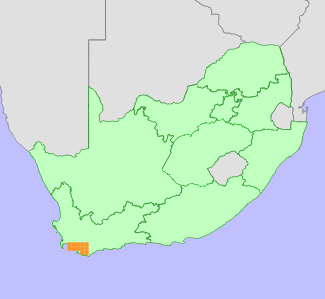|
Scientific Name | Paranomus sceptrum-gustavianus (Sparrm.) Hyl. |
Higher Classification | Dicotyledons |
Family | PROTEACEAE |
Synonyms | Nivenia sceptrum R.Br. |
Common Names | King Gustav's Sceptre (e) |
National Status |
Status and Criteria | Least Concern |
Assessment Date | 2020/04/19 |
Assessor(s) | A.G. Rebelo, D. Raimondo, L. von Staden & N.A. Helme |
Justification | Paranomus sceptrum-gustavianus is endemic to the Fynbos Biome of South Africa, with an extent of occurrence (EOO) of 4476 km² and an area of occupancy (AOO) of 296 km². It occurs as small subpopulations scattered throughout suitable montane habitat. There are 93 subpopulations recorded and we suspect that over 100 subpopulations are likely to exist. There are no severe threats to this species and it therefore qualifies as Least Concern. |
Distribution |
Endemism | South African endemic |
Provincial distribution | Western Cape |
Range | This species is endemic to the mountains of the Western Cape Province in South Africa, occurring from the Hottentots Holland to the Riviersonderend Mountains. |
Habitat and Ecology |
Major system | Terrestrial |
Major habitats | South Sonderend Sandstone Fynbos, Overberg Sandstone Fynbos, Kogelberg Sandstone Fynbos |
Description | Plants grow in sandstone fynbos on mid-upper slopes with a moist, south aspect. Mature individuals are killed by fires, and only seeds survive. Seeds are released after ripening, and dispersed by ants to their underground nests, where they are protected from predation and fire. It is pollinated by insects. |
Threats |
| The only threat to this species is competition from invasive alien plants (Pinus sp.). The vast majority of subpopulations are however not impacted by invasives, and where pines have been observed, they occur at low densities and are not yet causing the population to decline. |
Population |
This species occurs as small subpopulations typically fewer than 10 plants. A handful subpopulations of over 100 plants have been recorded. A total of 93 subpopulations have been documented but many mountain slopes within it's range remain unexplored and hence the total populations size cannot be estimated.
|
Population trend | Decreasing |
Conservation |
| It is protected at Kogelberg, Hottentot Holland, Riviersonderend, Greyton, Fernkloof and Maanschynkop nature reserves and Klein Houwhoek and Vogelgat Private Nature Reserves. It is vulnerable to harvesting for the cut flower trade and as it has a highly sensitive life history, harvesting is not allowed (Privett et al. 2005). |
Assessment History |
Taxon assessed |
Status and Criteria |
Citation/Red List version | | Paranomus sceptrum-gustavianus (Sparrm.) Hyl. | NT B1ab(i,ii,iii,iv)c(iv) | Raimondo et al. (2009) | |
Bibliography |
Goldblatt, P. and Manning, J.C. 2000. Cape Plants: A conspectus of the Cape Flora of South Africa. Strelitzia 9. National Botanical Institute, Cape Town.
Manning, J.C. and Goldblatt, P. 2012. Plants of the Greater Cape Floristic Region 1: The Core Cape Flora. Strelitzia 29. South African National Biodiversity Institute, Pretoria.
Privett, S., Bailey, R., Raimondo, D., Kirkwood, D. and Euston-Brown, D. 2005. A vulnerability index for rare and harvested plant species on the Agulhas Plain. Flower Valley Conservation Trust.
Raimondo, D., von Staden, L., Foden, W., Victor, J.E., Helme, N.A., Turner, R.C., Kamundi, D.A. and Manyama, P.A. 2009. Red List of South African Plants. Strelitzia 25. South African National Biodiversity Institute, Pretoria.
Rebelo, T. 2001. Sasol Proteas: A field guide to the proteas of southern Africa. (2nd ed.). Fernwood Press, Vlaeberg, Cape Town.
|
Citation |
| Rebelo, A.G., Raimondo, D., von Staden, L. & Helme, N.A. 2020. Paranomus sceptrum-gustavianus (Sparrm.) Hyl. National Assessment: Red List of South African Plants version 2024.1. Accessed on 2025/10/14 |
 Comment on this assessment
Comment on this assessment

